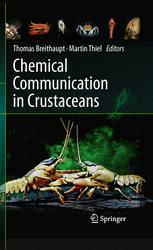

Most ebook files are in PDF format, so you can easily read them using various software such as Foxit Reader or directly on the Google Chrome browser.
Some ebook files are released by publishers in other formats such as .awz, .mobi, .epub, .fb2, etc. You may need to install specific software to read these formats on mobile/PC, such as Calibre.
Please read the tutorial at this link: https://ebookbell.com/faq
We offer FREE conversion to the popular formats you request; however, this may take some time. Therefore, right after payment, please email us, and we will try to provide the service as quickly as possible.
For some exceptional file formats or broken links (if any), please refrain from opening any disputes. Instead, email us first, and we will try to assist within a maximum of 6 hours.
EbookBell Team

4.7
86 reviewsCrustaceans are ecologically and economically important. They are fished and farmed extensively for food and are model organisms for scientific research. However, as invasive species, some crustaceans also threaten native communities world-wide. Social interactions of these primarily aquatic invertebrates are generally mediated through chemicals. Hence, the study of chemical communication by crustaceans is fundamental to understanding their biology and developing strategies to manage and protect them. Research in this area also promises discoveries of new waterborne natural products. This book provides the first comprehensive synthesis of current knowledge on crustacean chemical communication. Leading experts review different aspects of chemical communication and share their fascination with their research with the reader. Opening with an overview of the challenges and concepts of crustacean chemical communication research, the book proceeds to explore signal transmission and reception, and neural processing. The behavioral context of chemical communication is reviewed for the best-studied species. Recent advances in the molecular identification of crustacean chemical signals are presented, followed by discussions of their possible applications in aquaculture and management. Additional chapters provide complementary knowledge from other taxa (fish, insects) and topics (multimodal communication, deception, ecotoxicology), highlighting opportunities for future research. The book is richly illustrated and avoids technical jargon, making it accessible to a broad readership including researchers and students of ecology, evolution, behavior, and neurobiology, as well as non-scientists interested in fisheries, aquaculture, and environmental management. “This excellent and comprehensive volume fills a major gap in the field of chemical ecology and behavioral physiology. The editors assembled an outstanding group of expert contributors.” - Bert Hölldobler, Arizona State University and University of Würzburg “The topics are timely, the reviews current and the approach refreshingly synthetic. I see this book being useful for many years to come to the entire community of aquatic chemical ecologists.” - Peter W. Sorensen, University of Minnesota “The chapters are lucidly written by the outstanding experts in their fields. The book is a must-read for all those interested in the underwater world.” - Jelle Atema, Boston University and Woods Hole Oceanographic Institution ABOUT THE EDITORS Thomas Breithaupt is a lecturer in the Department of Biological Sciences at the University of Hull (UK) where he studies the mechanisms and evolution of chemical communication and orientation in crustaceans and fish. Martin Thiel is professor of Marine Biology at Universidad Católica del Norte in Coquimbo (Chile) where together with his students he uses crustaceans as model organisms to study the evolution of social behavior in the sea.